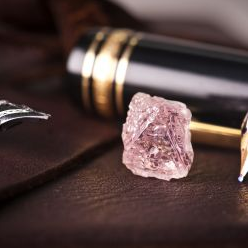 The Argyle Diamond Mine Company in Western Australia announced last week that it had unearthed a 12.76 ct. pink diamond, the largest in the Mine’s history.
The Argyle Diamond Mine Company in Western Australia announced last week that it had unearthed a 12.76 ct. pink diamond, the largest in the Mine’s history.
The Mine is calling the new find “The Argyle Pink Jubilee.”
Pinks are in one of the most exclusive clubs in the world – ultra-rare colored diamonds called “fancies.”
Until the 1980s when pinks were discovered by the Argyle Diamond Mine Company, they were virtually unknown. In fact, today, almost all the world’s pink diamonds come from the Argyle which also produces a large percentage of the world’s brown (champagne and cognac) diamonds. Argyle itself estimates that it supplies 90% of the world-wide market for pink diamonds.
Most colored diamonds (and other gemstones) derive their color from impurities in the stone. As an example, the presence of boron in a diamond can give it a color ranging from “ice blue” to grey-blue to deep dark peacock blue. The presence of nitrogen can color a diamond a yellow, golden or green.
But pinks are different. No one really knows what causes the distinctive colors of pink diamonds, although there is a widely accepted theory.
It’s believed that the pink color is caused by a distortion in the diamond’s crystal lattice due to intense heat and pressure during or after the stone’s formation in the earth. The heat and pressure act to displace carbon atoms from their normal positions altering the qualities of light reflected by the diamond.
But the mystery of its color origin adds to its mystique. On a per carat basis, high quality pinks are among the most expensive gemstones in the world, if not the most expensive. As one example, a 5.00 carat cushion-shaped fancy vivid pink was sold for $10.8 million at auction in 2009.
Experts believe the Argyle Pink Jubilee might rival this record when it is sold at the company’s annual tender, although it’s not clear at this point how much of the stone will be lost during cutting and polishing. (Argyle says it will take up to two months to just plan the cutting and polishing and about 10 days to actually accomplish it. Gemstones can lose significant numbers of carats during this process. Expert diamond polisher Richard How Kim Kam who has worked for Argyle for 25 years will do this work.)
The Argyle Pink Jubilee is being compared to the Williamson Pink, which was discovered in Tanzania and given to Princess Margaret upon her engagement to Prince Phillip. Until the discovery of the Pink Jubilee, the Williamson was considered the finest pink in existence.
Argyle is notable for its pink and brown diamonds. However, it should also be remembered that Argyle was the first mining company to announce it would not extend its contract with DeBeers. This was back in 1996 when DeBeers still controlled a majority of the world’s diamonds. At that time, the break with DeBeers was considered risky and courageous.

